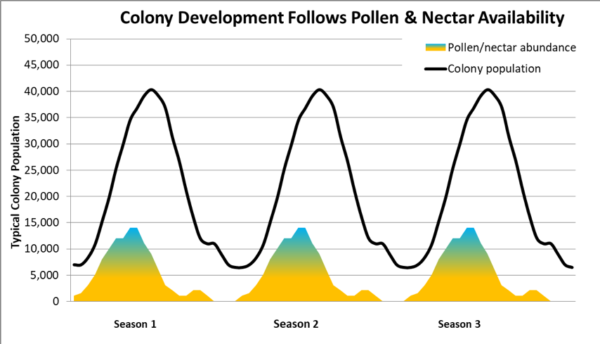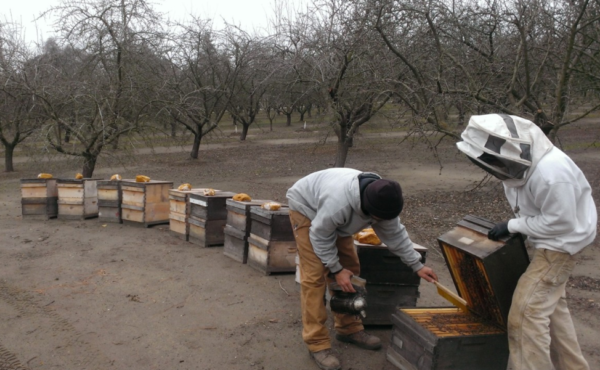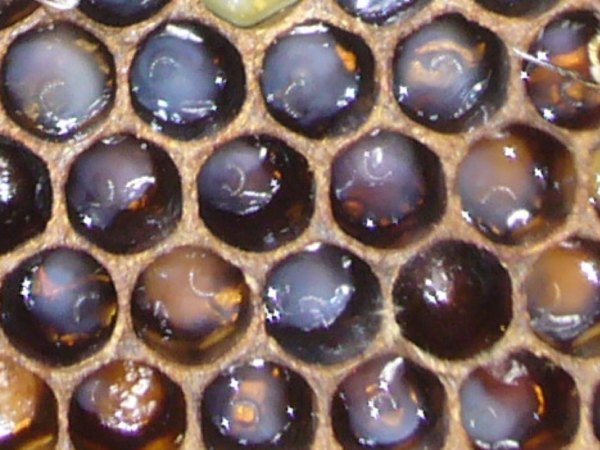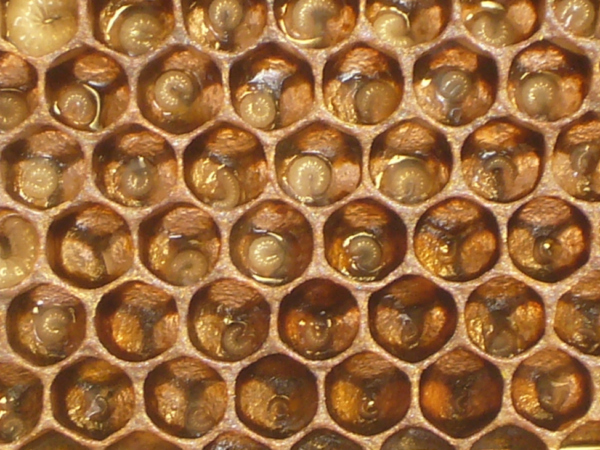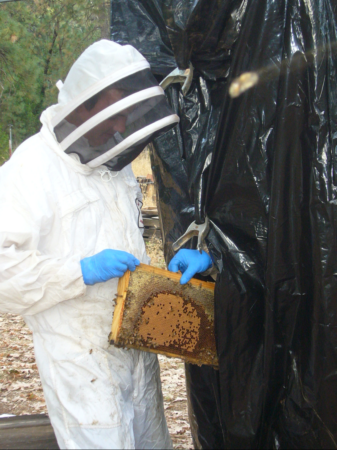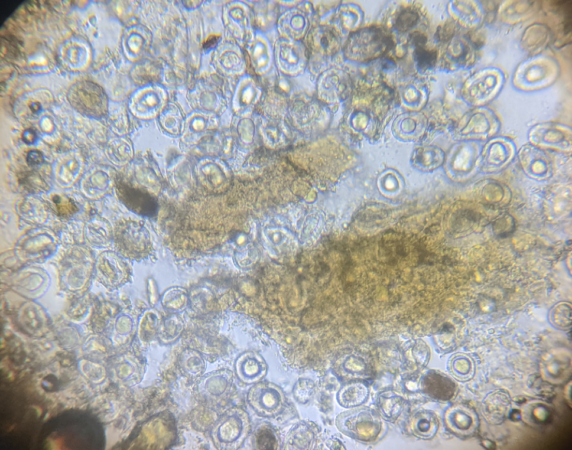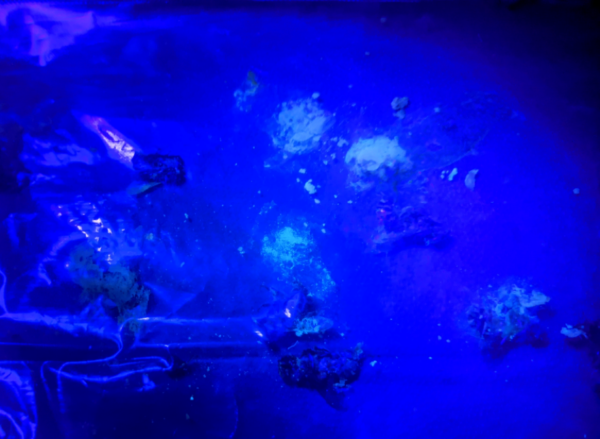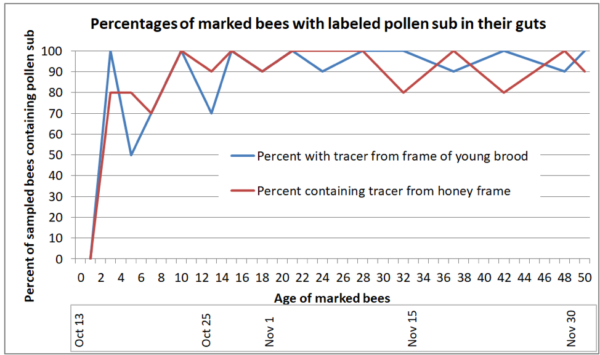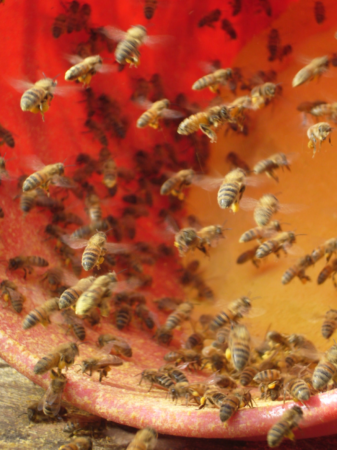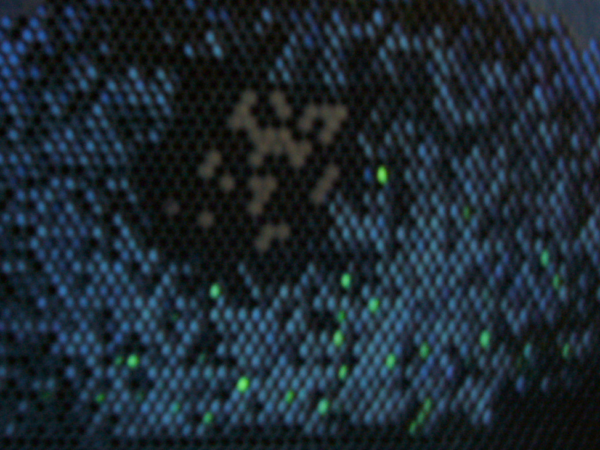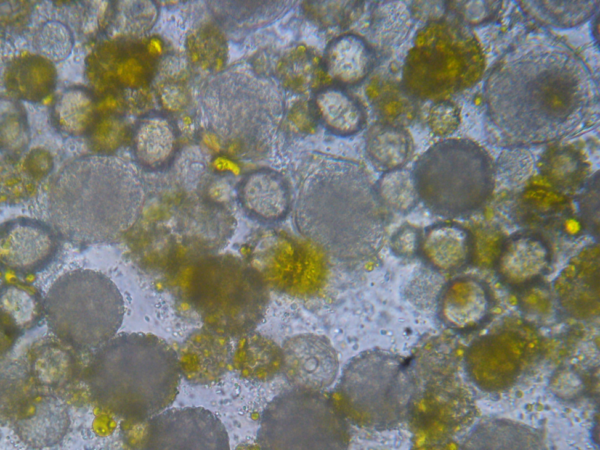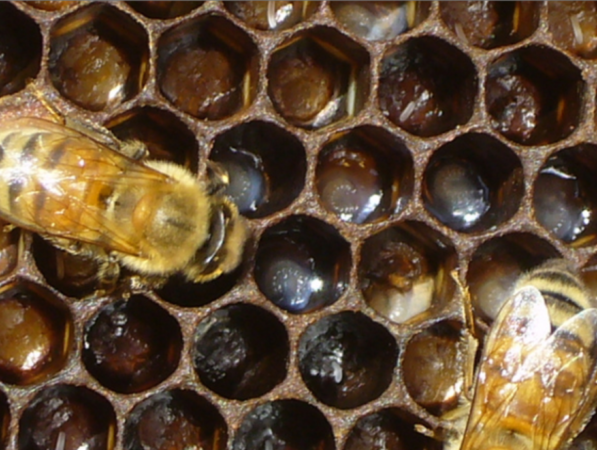Observations on Pollen Subs
Observations on Pollen Subs
Part 1
First published in ABJ July 2021
Randy Oliver
ScientificBeekeeping.com
I get a lot of questions about what the bees do with pollen subs, why, when, and how to feed them, or even if it’s worth the effort. Since I’ve done a goodly amount of investigation on this subject, allow me to share some of the things that I’ve learned.
Beekeeping in the California Foothills
In the Sierra Foothills our colonies hunker down for a month or so starting in November for our mild but snowy winter, then slog through a long, rainy late winter/spring, take advantage of a nectar and pollen flow from mid-May through the end of June, and then survive a bone-dry summer (often with not enough rain to wet the ground from mid-May until mid-October). Due to the lack of nectar and pollen late in the season, I moved my hives out of state during the summer for over 20 years.
But once varroa arrived, I found that I could better care for my bees if I left them home, and fed them pollen sub when indicated. My sons and I have successfully done this for many years now. But that doesn’t mean that there’s a standard formula for the feeding of pollen sub that applies everywhere, or even every year.
Colony Buildup Follows Pollen (and Nectar) Flows
There are typically four phases per season for a honey bee colony (Figure 1):
- Buildup on early pollen and nectar, followed by
- Reproduction (drone production and swarming), then
- Food Storage (putting up a reserve of honey to make it through the Dearth), and
- Survival through the Dearth (which may or may not coincide with the short days of winter).
Fig. 1 Note how colony buildup lags roughly a brood cycle or so behind pollen/nectar flows. If the colony gains enough strength, it will reproduce by swarming if there is still a pollen/nectar flow going on. Colonies don’t attempt to maintain a large cluster in times of dearth, and reduce the number of mouths to feed. In some areas, there may be two buildup and storage phases in a single season (such as when there are both strong springtime and autumn flows with an intervening dearth period.
In much of North America, there may be an August dearth period, then an autumn flow from fall-blooming plants, followed by a winter dearth if the temperature drops below flight temperature (since bee-pollinated plants don’t produce pollen or nectar when it’s too cold for bees to fly). But in Mediterranean climates, the dearth period occurs from July through October, with nectar and pollen flows occurring again in November through June. Thus the seasonality of the cycles above has more to do with temperature and rainfall than with day length or the calendar.
Return on Investment
If the weather cooperates, in many areas there would be no reason for the feeding of pollen sub — just let the bees do their thing. On the other hand, if you’re preparing your hives for a $200 rental contract in almonds, or a potential 200-lb. honey crop, it can be worthwhile to invest some money in pollen sub.
Practical application: In Chile there are far more hives of bees than required for the pollination of the small number of acres planted to almonds. So beekeepers there place their hives in almonds free of charge in order to take advantage of the pollen flow (as it used to be in California). They do this to build up their colonies in anticipation of later rental contracts in other tree crops, for which they get paid. Thus it isn’t worthwhile for them to spend much money on pollen sub prior to almond pollination.
It’s All About Your Goal, Pollen Availability, and the Weather
If your goal is to supply strong colonies in almonds, then they must go into winter with large clusters. If you live in an area in which there is not an autumn pollen flow to stimulate brood rearing, then the feeding of pollen sub can give you a very good return on investment.
Come springtime, I’ve found that if there is a natural pollen flow going on, then it’s a waste of money to feed pollen sub ([1]). But what if the weather turns bad? For example, in my area prior to almond pollination, if the weather is warm enough for our bees to forage, then there may be enough pollen coming in from alder trees and other sources to maintain colony buildup, and any feeding of pollen sub doesn’t make a whit of difference [[2]]. But if it’s rainy in January and early February, feeding pollen sub in the rain can make all the difference as far as making grade in the almonds (Figure 2).
Fig. 2 We sometimes need to take rapidly-growing colonies off of natural pollen/nectar flows in the foothills in early February, and place them in almond orchards in the forage desert on the cooler Valley floor until the early cultivars start coming into bloom in a week or so. So we’ll give the hives a 3-lb. chunk of pollen sub so as not to lose their momentum of buildup.
On the other hand, for hobby beekeepers not going to almond pollination, feeding pollen sub to stimulate early buildup might simply lead to excessive swarming earlier in the spring.
At the other end of the season, in areas with autumn pollen/nectar flows from goldenrod and asters, the feeding of pollen or pollen sub may prolong fall broodrearing slightly, but won’t make the winter cluster any larger [[3]]. But in my area of California, autumn feeding of pollen sub can make the difference between a colony going to almonds the following February or not.
The question that I get from many beekeepers is how to know when it’s worthwhile to feed?
Don’t Ask, Just Look!
In any colony, it’s the nurse bees that run the show. If they detect that there’s a pollen flow going on, they’ll lavish the queen and larvae with nutritious jelly (Figure 3).
Fig. 3 First- and second-instar larvae “swimmin’ in jelly.” This tells you that the nurse bees are enjoying an abundance of good nutrition, and are in buildup mode. Pollen sub would be of no benefit to this colony.
Fig. 4 At the other extreme, the nurses are providing these larvae with barely enough jelly to stay alive. Feeding a high-quality sub can allow the nurses to start producing more jelly by the next day, and quickly put this colony back into buildup mode.
Practical application: Rather than following blanket recommendations, beekeepers can simply look into their hives to see how much pollen is coming in, whether there is a reserve around the brood, and most importantly, monitor how generous the nurses are with the jelly that they are feeding to 2nd-instar larvae. And then they can decide whether their management goal calls for supplemental feeding or not.
Any proactive colony management decisions should be based upon looking ahead to the date of your goal, since it takes about two brood cycles to substantially grow a colony. So to stimulate colony buildup in anticipation of pollination contracts, a honey flow, or to produce the cohort of long-lived workers that will form the winter cluster, the beekeeper can monitor how much jelly the nurses are supplying to the young larvae during the 6-week period leading up to the goal. If, due to lack of natural forage or unfavorable weather, the nurses start to cut back on jelly production, the feeding of a few pounds of pollen sub can get them pumping again in a couple of days.
Note: Simultaneous feeding with light sugar syrup, in order to simulate a nectar flow, is generally stimulatory, but we find that at least for late-winter or autumn broodrearing, syrup may not be necessary if the colonies have plenty of honey at hand. I’m still trying to figure out just how important sugar syrup is for stimulation during dry summer weather.
What do Colonies do with Pollen Sub?
I was curious about this question back in 2013, so I mixed fluorescent tracers into pollen sub, fed it to colonies, and then inspected the frames afterwards under ultraviolet light (Figure 5).
Fig.5 We used a double layer of black plastic hung over the forks of our forklift to create a darkroom next to the test hives. Eric stayed inside in the dark, while we passed him every comb from each hive to search for any traces of luminescence from the fluorescent pollen sub. There was only the occasional speck where it had stuck to honey that a bee had been eating.
We found that the bees either consume the patty, or suck the sugar out of it and throw it out of the hive (as they do if you feed pollen sub during a pollen flow) — none is stored in the combs, nor did we see any fluorescence in the larvae or larval food. We also shook a sample of 50 bees from each frame, froze the bees, and then squashed them under black light to look at their gut contents under black light.
Practical application: Fed pollen sub in patty form may be consumed by the bees, or discarded, but they do not store it as beebread. We found workers with fluorescent gut contents distributed throughout the hives, not necessarily on the brood frames.
In another experiment, I crushed 50 bees on November 17 as a colony went into winter cluster [[4]]. I was greatly surprised to find that every single bee had a gut full of pollen. I don’t yet know whether this is a common behavior for the long-lived diutinus bees that form the winter cluster. If so, it suggested that it might be beneficial during an autumn pollen dearth to provide pollen sub late in the season in order for the diutinus bees to fully develop their fat bodies.
Practical application: Observations by Seeley [[5]] indicate that worker bees typically cease consuming pollen when they shift from nursing behavior at around 13 days of age. But there are conflicting findings in the literature as to where in the hive bees of nursing age are typically found [[6]]. Behavioral observations are typically based upon tracking paint-marked cohorts of bees to record where in the hive they are located, or whether they place their heads into cells containing beebread. On the other hand, my own studies have involved actually inspecting the guts of workers to see whether they contain pollen or fed pollen sub.
In the Sierra Foothills in autumn, foragers may fill the combs with rust fungus spores, which the nurses either consume immediately, or store as beebread [[7]]. Our colonies quickly go downhill on such a diet. But if we feed pollen sub, the nurses respond by immediately producing more jelly and ramping up broodrearing, thus allowing us to build up colonies destined for almond pollination the following February.
So I ran an experiment to determine whether workers that emerged in autumn would preferentially feed upon those rust spores or fed pollen sub, and whether they would continue to consume proteinaceous food past “normal” nurse bee age. I tested various fluorescent tracers to label the sub, and found some (that fluoresced blue or white), that stood out from any fluorescence from natural pollen or rust fungus spores. I then paint-marked 605 workers (newly emerged in an incubator) on October 13, returned them to their hive, and repeatedly fed the colony fluorescent-labeled pollen sub for the duration of the trial (while the foragers continued to bring in rust spores and some pollen.
Then, daily, and later every few days, I collected 10 of that marked bee cohort from both a brood comb and a honey comb, froze them, crushed them, and viewed their gut contents for the presence of fluorescent material (Figures 6 & 7). Since the guts of foragers are generally free of any food material, it was easy to tell whether the marked bees were consuming pollen, pollen sub, or a combination (most all contained one or both). I continued to sample the marked bees until December 2. The results are shown in Figure 6.
Fig. 6 Typical gut contents of the marked workers over the course of the experiment, viewed under white light at 400x. The yellow-orange blobs are particles of pollen sub; the objects that look like fried eggs are fungus spores, which are a terrible food for bees. This sort of mixture was consistent in the bee guts over the entire course of the experiment from mid-October through November, indicating the benefit of feeding pollen sub during that time period.
Fig. 7 Crushed bees in a plastic bag viewed under ultraviolet light. I had added white and blue fluorescent tracers to the fed pollen sub. The three crushed guts that glow white are from bees whose guts were filled with labeled pollen sub alone, as opposed to the dark blotches of mostly rust spores in the guts to the left, or mixed spores and pollen sub to the bottom right.
Fig. 8 None of the workers had fed on pollen sub on Day 1, but most had by Day 3. Most every sampled bee had either pollen or pollen sub in its gut — most with a mixture of the two, and a few had consumed nearly straight pollen sub. Brood rearing was winding down, and there were few young larvae as of November 25. These observations indicate that worker bees that emerge late in the season to form the winter cluster do not cease feeding on pollen after the typical cessation (at around 13 days of age) exhibited by nurses, but continue to consume pollen or pollen patty even at 50 days of age.
Practical application: Although the bees do not move fed pollen sub patty to the combs for storage, the “winter bees” do “store it” in their guts. This finding helps to answer the question as to whether late feeding of pollen sub can help the “winter bees” with fat body development, which appears to be critical for their longevity. From practical experience, such artificial feeding really helps our colonies in the arid foothills.
What about Dry Feeding Pollen Sub?
Pollen sub can also be dry fed in the yard. I’ve measured how many pounds of dry sub a group of colonies will collect in a day, and found that it’s as much as if a beekeeper was opening the hives to feed patties. Ideally, dry feeding could be a real labor saver, since all you need to do is place the dry powder out of the rain (Figure 9).
Fig. 9 Foragers eagerly collecting dry pollen sub from an open bucket. But what do they do with it when they return to the hive?
Fig. 10 I took this photo one hour after placing fluorescent-labeled dry pollen sub out at a feeding station. You can make out the patch of brood in the center of the comb, with bluish beebread of rust spores and natural pollen surrounding it. The green glows are from the fluorescent-labeled dry sub fed in the last hour. The bees packed it right into cells along with natural pollen from other foragers.
I removed some of the glowing beebread, and viewed it at 400x (Figure 11).
Fig. 11 Beebread consisting of natural pollen grains mixed with powdered pollen sub (the yellowish chunks).
Hungry nurse bees eagerly consume the dry-fed pollen sub from the cells — their gut contents look similar to the photo above. And in response to the dry-fed sub, within a day the nurses increase the amount of jelly being fed to the larvae (Figure 12).
Fig. 12 The larvae in this colony were looking pretty “dry” the day before. The jelly around them was in response to dry-fed pollen sub. It’s easy for the beekeeper to see and monitor the effect of feeding pollen sub.
Aha! I thought — why should I feed patties when dry feeding is so much easier? Well, there were two things:
- The colony-to-colony foraging on the dry sub was very erratic. Some colonies gathered quite a bit and brooded up, but other colonies in the same yard ignored it. Colony buildup was far more consistent when we fed pollen sub in patty form placed into the hives.
- Some large-scale beekeepers (including myself) report that they’ve had negative experiences after dry-feeding pollen sub in autumn.
Because of observation number 2, I collected and froze combs containing either fresh beebread made from natural pollen, or beebread made from dry-collected pollen sub, and shipped them to the USDA Anderson Lab in Tucson, Arizona for testing. Patrick Maes then fed caged bees fresh or aged beebread of both types. He found that when fed fresh, the bees did fine on both the natural and artificial beebread. But when it was aged for 2-3 weeks, the artificial beebread resulted in slightly increased mortality and less thoracic weight gain, compared to aged natural beebread [[8]].
Practical application: As a coauthor of the paper, I’ll be the first to say that we should be careful about interpreting the results of a single cage trial. I’d love to hear from other beekeepers who have had either positive or negative experiences from autumn dry-feeding of pollen sub.
To be Continued
Dang, out of space already. What this article started to be about was trying to figure out why we couldn’t get the colonies to grow during my comparative trial (see the accompanying article). I guess I’ll have to wait until next month.
Citations
[1] http://scientificbeekeeping.com/when-to-feed-pollen-sub/
[2] See Figure 18 at http://scientificbeekeeping.com/a-comparative-test-of-the-pollen-sub/
[3] Mattila, HR & GW Otis (2007) Manipulating pollen supply in honey bee colonies during fall does not affect the performance of winter bees. Can. Entomol. 139: 554-563.
[4] See Figure 3 at http://scientificbeekeeping.com/understanding-colony-buildup-and-decline-part-13b/
[5] Seeley,TD (1982) Adaptive significance of the age polyethism schedule in honeybee colonies. Behavioral Ecology and Sociobiology 11(4): 287-293.
[6] Free, JB (1960) The distribution of bees in a honey-bee (Apis mellifera L) colony. Proceedings of the Royal Entomological Society of London (A) 35: 141-141.
Johnson, BR (2008) Within-nest temporal polyethism in the honey bee. Behav Ecol Sociobiol 62:777–784.
van der Steen, JM, et al (2012) How honey bees of successive age classes are distributed over a one storey, ten frames hive. Journal of Apicultural Research 51(2): 174-178.
[7] http://scientificbeekeeping.com/fried-eggs-identified/
[8] Maes, PW, P Rodrigues, R Oliver, B Mott, K Anderson (2016) Diet-related gut bacterial dysbiosis correlates with impaired development, increased mortality and Nosema disease in the honeybee (Apis mellifera). Mol Ecol 25(21): 5439-5450.




